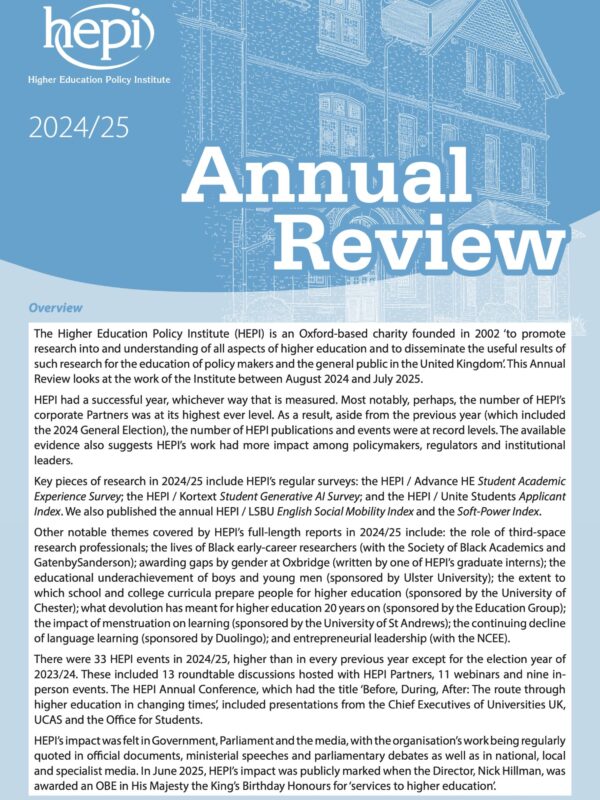10 points of note in today’s OECD ‘Education at a Glance’ report
- This morning, HEPI and Cambridge University Press & Assessment, are hosting the UK launch of the OECD’s Education at a Glance, which is the most important annual international comparative education publication produced anywhere in the world.
- Here, HEPI Director, Nick Hillman, takes a look at what it says.
The OECD’s Education at a Glance is the most important and the most mis-named publication in education, for this year’s edition is 541 pages long! It will take time to digest in full. But for now, here are 10 key points on what it all means for the UK (and especially England):
- In England, you’re less likely to have benefited from tertiary education if your parents had a relatively low level of education … but you’re more likely to have had some tertiary education than similar people in other developed countries. This may be a surprise to people who know we still have a long way to go in widening access to higher-level education but it’s not a big surprise to anyone who has looked very closely at first-in-family students – there’s multiple ways to measure who is a first-in-family student but, on some measures, the majority of students these days are first-in-family.
- The NEETs (young people Not in Employment, Education or Training) challenge is bad and has been getting worse, especially among men. Again, this won’t come as a huge surprise to anyone who has focused on the terrible educational and employment record of lower educated young men – or who has read HEPI’s recent report on the issue. But it is salutary to find out the UK is not only performing badly but that we are performing the worst of any developed country when it comes to earnings for low-skilled adults: ‘25-34 year-olds with below upper secondary education earn 43% less than those with upper secondary or post-secondary non-tertiary attainment, the largest gap among OECD countries’.
- Part of the reason for the UK’s comparative success at higher education relative to other countries is the comparatively low drop-out rate. Again, this is covered by a recent HEPI report, which also noted that new initiatives like the Lifelong Learning Entitlement call for a new conception of non-continuation.
- People often say it’s better to invest government money in the compulsory stage of education rather than the tertiary / voluntary stage. The OECD’s numbers suggest the UK has already taken this policy to its extreme. Government spending on higher education (per student) is around $8,000, around half of the average for the OECD and about half of the amount spent ‘at primary to post-secondary non-tertiary levels’ ($13,000). This is an even more extreme way of describing comparative spending on schooling and higher education than the way I put it in a recent speech.
- While there is one international student for every three home students in the UK, across the OECD as a whole the ratio is completely different at 1:13. From the vantage point of the OECD in Paris, this is a real UK success story – though the Home Office continues to push for policies to reverse recent trends.
- Our postgraduate participation rates for home students are distinctly average, at least when compared to those across the OECD as a whole: ‘In the United Kingdom, 17% of 25-34 year-olds hold a master’s or equivalent degree, which is similar to the OECD average of 16%.’ If we aspire to be as well educated as the best educated countries, then we need more home postgraduates alongside all the ones from overseas. It’s probably fair to say that higher education debates in the UK (and HEPI is perhaps guilty here too) remain overly focused on undergraduate education.
- Women are more likely to obtain tertiary education across the developed world. But the gap between men and women is bigger in the UK than elsewhere and has been slowly growing while it has stayed the same on average across the OECD as a whole: ‘In the United Kingdom, they [women] accounted for 56% of first-time entrants in 2023, up from 55% in 2013. Across the OECD, women make up 54% of new entrants on average, the same share as in 2013.’
- The teacher supply crisis here is particularly down to a higher-than-average proportion of teachers leaving for other roles: ‘England is among the countries with high turnover, with 0.8% of teachers retiring and 8.7% resigning each year’. The OECD think it should be easier for people to switch careers into teaching here: ‘16 out of 28 countries with available data offer dedicated alternative pathways into teaching for individuals changing careers. In contrast, England does not offer dedicated pathways for second career teachers.’ (Now Teach might have something to say about this?)
- In some important respects, our school system is different: primary school teachers’ salaries have been falling in England while rising elsewhere (including in Scotland); UK school pupils have around one week less of school holiday than pupils elsewhere on average (though I recognise this might sound odd at this precise moment, given the long summer holidays have just come to an end); and primary school class sizes are above average in the UK.
- There’s a (very) big difference between the conditions for lower-level academic staff and more senior ones. The former receive less than similarly qualified people while the latter earn much more: ‘In England, junior academic staff earn 16% less than workers with at least a bachelor’s or equivalent degree, while senior academic staff earn 80% more.’ Perhaps this explains why some older staff have seemed less keen on industrial action than their younger colleagues. Our report on academics’ terms and conditions explains more.







Comments
Add comment